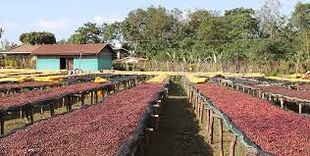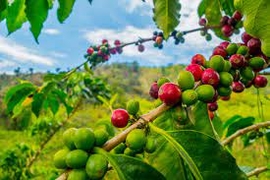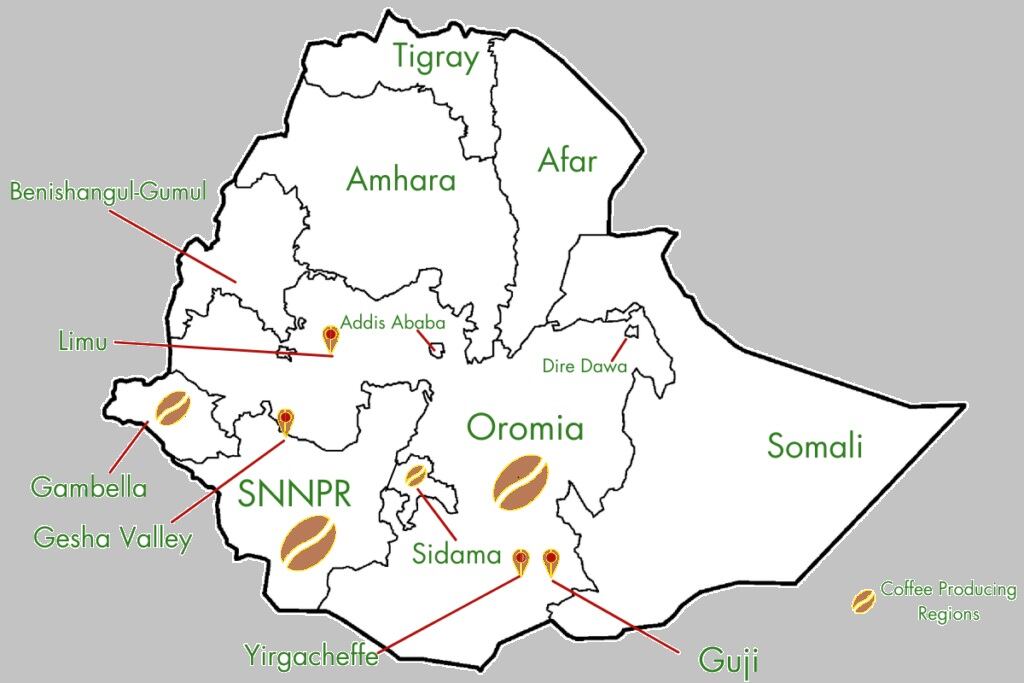Ethiopia, often referred to as the birthplace of coffee, is renowned for its rich coffee culture and diverse array of coffee-growing regions. From the lush highlands of Sidamo to the arid landscapes of Harrar, each region offers distinct flavor profiles and characteristics that capture the essence of Ethiopian coffee. As a passionate coffee lover, there’s nothing quite like exploring the unique tastes and aromas that emanate from these renowned growing regions. Join me on a journey as we delve into the enchanting world of Ethiopian coffee, exploring the main ethiopia coffee growing regions: Sidamo, Harrar, Yirgacheffe, Limu, and Guji.
Coffee Production in Ethiopia’s Growing Regions
| Region | Altitude Range | Processing Method | Flavor Profile |
| Sidamo | 1,500 – 2,200 m | Washed | Fruity, Floral |
| Harrar | 1,400 – 2,100 m | Natural | Bold, Fruity, Chocolatey |
| Yirgacheffe | 1,700 – 2,200 m | Washed | Floral, Citrus, Tea-like |
| Limu | 1,100 – 2,000 m | Washed | Smooth, Balanced, Chocolatey |
| Guji | 1,500 – 2,200 m | Natural | Sweet, Fruity, Berry-like |
Sidamo Region
Nestled in the fertile highlands of southern Ethiopia, the Sidamo region boasts an ideal climate for coffee cultivation. With elevations ranging from 1,500 to 2,200 meters above sea level and ample rainfall, Sidamo is celebrated for producing some of Ethiopia’s finest Arabica beans. One of the defining characteristics of Sidamo coffee is its vibrant acidity and complex flavor profile, often featuring fruity and floral notes that tantalize the taste buds.

I vividly recall my first encounter with Sidamo coffee—a delicate brew with a lively acidity reminiscent of ripe berries and a lingering floral finish. It was a sensory experience unlike any other, transporting me to the sun-drenched hillsides where these exquisite beans are meticulously grown and harvested. Whether enjoyed as a pour-over, espresso, or French press, Sidamo coffee never fails to captivate with its nuanced flavors and aromatic bouquet.
Harrar Region
Venturing to the eastern highlands of Ethiopia, we arrive in the ancient city of Harrar, renowned for its centuries-old coffee heritage. Situated at elevations ranging from 1,400 to 2,100 meters above sea level, Harrar’s arid climate and unique terroir contribute to the distinctive character of its coffee beans. Unlike the washed processing method prevalent in other regions, Harrar coffee undergoes a natural processing technique, where the beans are sun-dried with the fruit intact, imparting a bold and fruity flavor profile.
My encounter with Harrar coffee left an indelible impression, with its robust body and exotic notes of blueberry and dark chocolate. There’s an inherent mystique surrounding Harrar coffee, evoking images of bustling markets and ancient trade routes that have shaped its rich history. Each sip is a journey through time, a celebration of Ethiopia’s enduring coffee legacy and the craftsmanship of its skilled farmers.
Yirgacheffe Region
Moving south to the verdant hillsides of Yirgacheffe, we discover a coffee-growing paradise renowned for its exceptional quality and vibrant flavors. Situated at elevations ranging from 1,700 to 2,200 meters above sea level, Yirgacheffe benefits from abundant rainfall and fertile soil, creating an ideal environment for coffee cultivation. One of the hallmarks of Yirgacheffe coffee is its distinctive floral and citrus notes, a testament to the region’s unique microclimate and meticulous processing methods.

My experience with Yirgacheffe coffee was nothing short of revelatory, with its bright acidity and delicate tea-like qualities dancing on my palate. There’s a purity and elegance to Yirgacheffe coffee that sets it apart, a reflection of the land and the people who nurture these precious beans with care. Whether enjoyed as a single-origin espresso or a refreshing cold brew, Yirgacheffe coffee never fails to evoke a sense of wonder and admiration for Ethiopia’s natural bounty.
Limu Region
Journeying to the southwestern highlands of Ethiopia, we arrive in the picturesque region of Limu, known for its lush forests and abundant rainfall. Situated at elevations ranging from 1,100 to 2,000 meters above sea level, Limu offers a diverse array of coffee varietals renowned for their smooth and balanced flavor profiles. Unlike regions like Harrar and Yirgacheffe, Limu coffee typically undergoes a washed processing method, resulting in a clean and crisp cup with subtle hints of chocolate and caramel.
My introduction to Limu coffee was a revelation, with its velvety body and decadent notes of cocoa lingering on my palate. There’s a warmth and familiarity to Limu coffee that instantly draws you in, like a comforting embrace on a chilly morning. Whether savored as a classic drip brew or a velvety latte, Limu coffee embodies the essence of Ethiopian hospitality and the timeless allure of its coffee-growing regions.
Guji Region
Our final destination takes us to the southeastern highlands of Ethiopia, where the lush landscapes of the Guji region are home to some of the country’s most sought-after coffee beans. Situated at elevations ranging from 1,500 to 2,200 meters above sea level, Guji benefits from a diverse range of microclimates that produce coffee beans with unparalleled complexity and depth of flavor. Known for its natural processing method, Guji coffee exudes a vibrant sweetness and intense fruitiness that captivate the senses.
My experience with Guji coffee was a revelation, with its explosive flavors of ripe berries and tropical fruits leaving me utterly spellbound. There’s an exhilarating energy to Guji coffee that ignites the senses and transports you to a world of pure indulgence. Whether enjoyed as a velvety cappuccino or a bold espresso shot, Guji coffee is a testament to Ethiopia’s rich coffee heritage and the boundless creativity of its coffee farmers.
Conclusion
In conclusion, Ethiopia coffee growing regions offer a kaleidoscope of flavors and experiences that celebrate the country’s rich cultural heritage and natural bounty. From the vibrant acidity of Sidamo to the exotic aromas of Harrar, each region tells a story of tradition, innovation, and the enduring spirit of Ethiopian coffee. As a coffee lover, exploring Ethiopia’s coffee-growing regions is a journey of discovery—a chance to connect with the land, the people, and the centuries-old traditions that have shaped one of the world’s most beloved beverages. So, the next time you savor a cup of Ethiopian coffee, take a moment to appreciate the intricate tapestry of flavors and aromas that reflect the beauty and diversity of this remarkable country.







